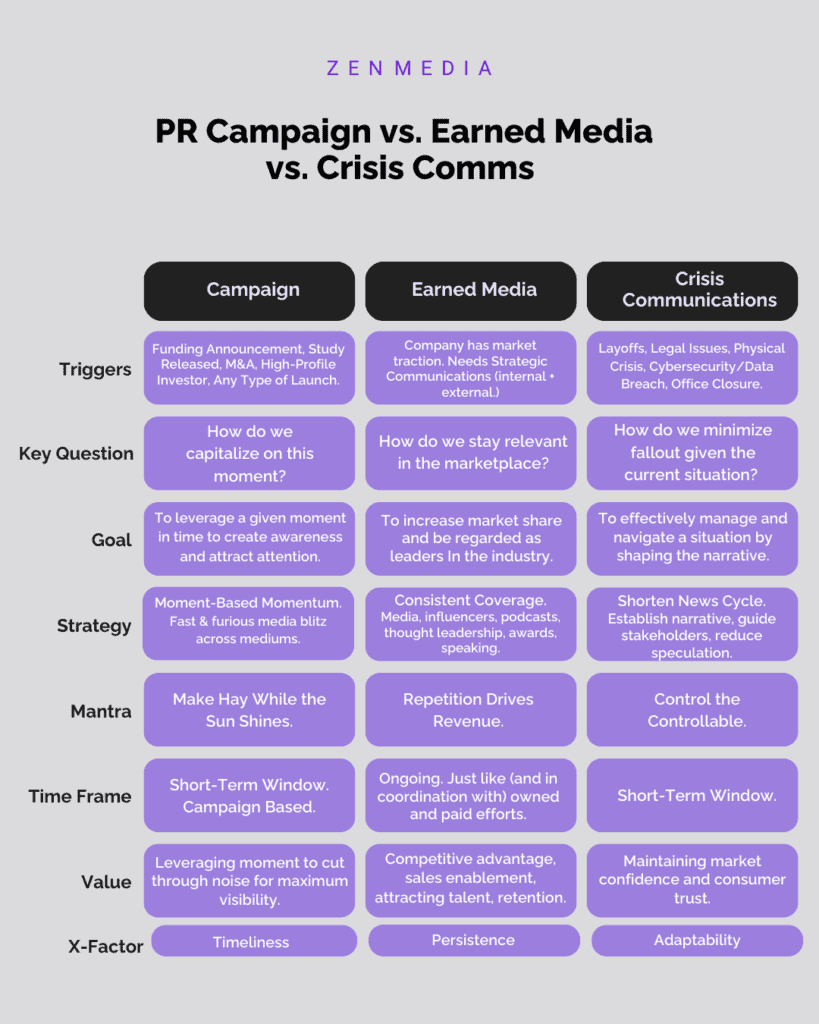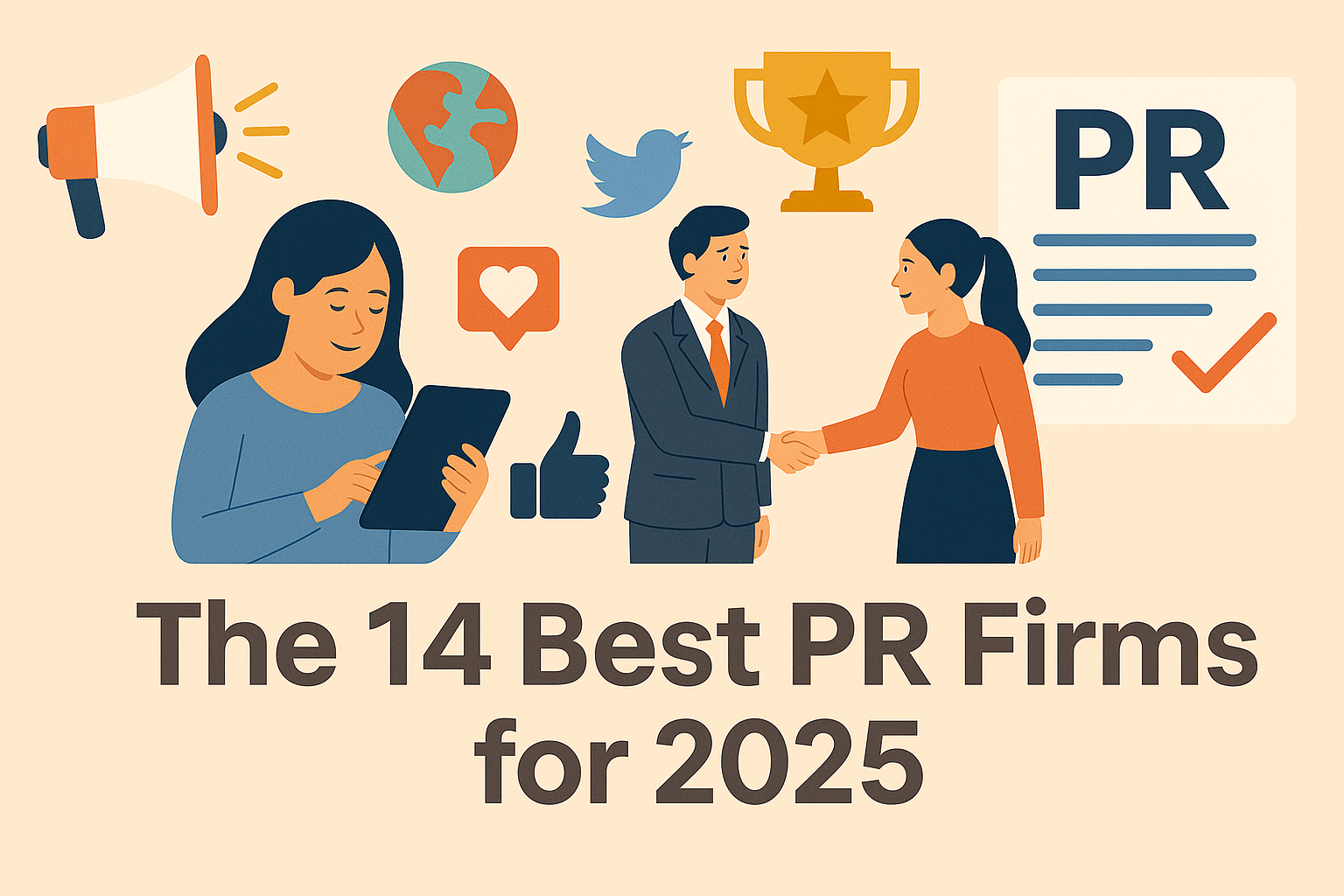Modern media relations can be complex. In fact, working in media and B2B marketing comes with its own lexicon. From SEO and SWOT analysis to bylines and CTAs, it can be a lot to keep up with. And because so many terms overlap, it’s easy to be confused.
On the surface, PR encompasses a wide range of communications practices, deliverables, and efforts to help tell a brand’s story to the public. Most of us working in the field would say PR is made up of several functions, including media relations, thought leadership, awards submissions, press releases, pitches, earned media, social media, events, and crisis communications.
While true, we’re missing out on the distinctions between three main focuses that are triggered by different events: PR, earned media, and crisis communications.
Defining PR, Earned Media, and Crisis Comms
The ambiguity between the definitions of PR, earned media, and crisis comms can cause confusion and inefficiencies when working with PR agencies or internal teams. When it comes to executing a successful B2B PR strategy, organizations will need to understand the differences between each function to establish the right timing, circumstances, and approaches to effectively leverage PR for your business.
Public Relations
The Public Relations Society of America defines PR as a strategic comms process that helps organizations build mutually beneficial relationships with the public, typically consisting of a targeted audience. This is a holistic approach to managing and enhancing the reputation of an organization.
The scope of work for PR consists of promotions through media relations, events, press releases, community relations, pitches, and more. This is done to shape and maintain a positive public image for an organization, product, or individual and to create strong relationships with stakeholders.
Earned Media
You know that thing everyone’s talking about? That’s earned media. In contrast to PR, earned media has a broader audience, allowing organizations to draw the attention of new or prospective customers. This is because earned media is publicity gained through non-paid promotional efforts such as word of mouth, organic news coverage, endorsements, dark social, and reviews.
While earned media is sparked by a brand’s marketing, PR, and advertising efforts, it also relies on an audience’s perception of your brand. For example, a fun video posted on social media can lean on trends to increase reach and engagement.
Earned media is typically considered more genuine than PR, driving media mentions, shares, reposts, and recommendations. With earned media, your brand gains credibility and visibility to increase SOV.
Crisis Comms
Do you know how to respond to the public in an emergency situation? Crisis communications is the act of managing and responding to unexpected and potentially damaging events that can harm an organization’s reputation, operations, or stakeholders.
This requires immediate yet intentional actions such as crafting response messages, liaising with media, communicating with stakeholders, engaging in corrective measures, and monitoring the situation. Crisis comms is implemented by PR teams to defend a brand from public scrutiny of its reputation, mitigate the impact of negative events, restore public trust, and prevent similar incidents.
Avoid missed opportunities
Key differences between PR and earned media lie in how much control a brand has over the messaging. While you can never ensure an influencer or journalist will share the exact message you want to communicate, PR provides brands more opportunities to maintain control or guide content—to an extent.
When comparing PR and earned media, it helps to look at the types of coverage each function might nmwith a brand spokesperson. Thought leadership also falls under earned media. While a bylined article is messaging directly from the brand, it is ultimately signed off by the publishing outlet.
In a crisis, public sentiment, brand history, additional players, and a variety of other external factors make it the least controllable form of PR. Even with preparation and carefully constructed messaging from one brand, crises involve multiple parties, increasing the chances of distortion or misrepresentation. While this can seem daunting, good PR teams know that consistent messaging distributed across various channels will help to drive the narrative a brand wants to communicate.
Accurately identifying which situations call for either strategic PR, earned media, or crisis comms is necessary to avoid strategy misalignment, wasted resources, and potentially damaging outcomes. By just lumping all three terms together, organizations lose the nuances each effort requires to be successful in its objective.
In fact, the main differences between each term lie in the causes, execution, and results implemented by PR teams. What news are you looking to break? Which audience do you want to reach? Do you want to share a press release, a short message, or conduct a comprehensive interview? Do you know how to create a blog or video that can be easily shared?
The key to getting a solution that will move the needle lies in communication with your PR team. This will help you understand what you need and why you need it, as well as provide you with an opportunity to effectively articulate these needs to your PR agency partner or internal team.
PR teams will then leverage that information to choose the right approach for you, looking into the triggers, key questions, goals, strategies, mantras, time frames, and values.

Seven factors to develop your PR strategy
Triggers
Triggers are the causes behind each communication strategy. For PR, this might include news about a merger or recent survey results. Earned media would come in the form of social media buzz surrounding an emerging company and a crisis could be sparked by layoffs or a data breach.
Key Questions
Key questions drive the next category, goals. But first, PR must consider the best ways to capitalize on news in the moment and generate media interest while earned media looks at longevity, wondering how to remain relevant in the marketplace. For crisis communication, the questions look at the situation and consider how to move forward with minimal damage to the brand’s reputation.
Goals
A PR goal looks at leveraging a given moment in time to raise awareness and attract attention. This might mean a new product launch or the appointment of a new CEO. Earned media hones in on ways to increase market share and be regarded as leaders in the industry. When people know about your company, they want to come to you first. In a crisis, PR teams will carefully and effectively manage a situation by navigating teams and shaping narratives.
Strategy
It’s no secret that the lifecycle of any story doesn’t last long these days, but your PR team knows how to use that to their advantage. A PR strategy focuses on the moment, firing a fast and furious media campaign across several platforms to push news. This involves building media lists and emailing press releases or media alerts to the right targets. Teams will follow up with additional information and calls to action.
Earned media is more consistent and requires a steady pace of outreach and media relations to achieve its goals. PR teams will lean on evergreen B2B content and thought leadership opportunities to provide a regular cadence of coverage. For crisis comms, brands are ideally looking to shorten the news cycle. PR teams will quickly and carefully construct messaging and share it with the appropriate audiences. Regular updates and a strong narrative are key here.
Mantra
Mantras provide short, digestible descriptions to help you identify the distinctions between efforts. PR looks at making hay while the sun shines. This means operating within an established window of opportunity and moment-based momentum. Earned media understands that repetition drives revenue and establishes longevity. For crisis communications, your team will need to understand what it means to control the controllable and focus all efforts on effective comms.
Time Frame
PR is campaign-based, meaning it has a shorter time frame than earned media, which relies on continuous efforts to see long-term results. Crises also operate with a short window of time, especially when managed effectively.
Value
Effective PR campaigns will seize the right moment and cut through the noise to land results and instantly improve your brand’s awareness. Because earned media has a longer lead time, it functions like building blocks that set up a strong foundation for current and future needs, such as sales enablement, talent recruitment and retention, and establishing a competitive advantage. Crisis comms is necessary to help a brand overcome a negative situation to maintain market confidence and consumer trust.
Separately, PR, earned media, and crisis comms are effective strategies to achieve a number of PR needs. When put together, each one positively contributes to the other.
A robust PR campaign helps to build credibility and increases organic traffic, putting your brand on the right journalist’s radar for a future piece. That credibility and established media relationship also becomes useful during a crisis when your response benefits from a positive track record and connections to trustworthy sources that can help you share your messaging.
Successful organizations will not only lean on all three efforts, they will implement PR teams that can distinguish between each strategy to find the right solutions.
Are you still unclear about the best approach for your B2B PR needs? Reach out any time. We’d love to build your PR strategy.





